|
The
Steiny Road Poet went
to Cuba in December and
anything else she did
in 2024 pales by
comparison.

Just as her 2009 trip to communist China, the People to
People experience in Cuba was eye-opening, given the way
American politicians have pitted their citizenry against
communism and socialism, systems of governance that emphasize
wealth equality. Our new president's threat to deport millions of
immigrants and his lopsided distribution of money to the
wealthiest promise to accentuate this bias even more. Steiny was
surprised to learn, despite the former support of the Soviet Union,
that Cuba, despite its one-party system of government called the
Communist Party of Cuba, is not a communist country and never
was. While Cuba followed Marxist-Leninist principles, it never
attained the final stage of communism. However, Cuba's
socialism, as conceived and enacted by Fidel Castro, is now giving
way to an entrepreneurial effort to counter the government's
failure to provide for basic needs.
While Steiny and her traveling companions—some previously
known and some new—stayed in luxury hotels (on a par with Las
Vegas), ate meat imported from Costco, and rode comfortable
touring coaches, she met people who had to scavenge every day
for their next meal—or for soap. She heard a woman asking sabón
sabón as her touring group walked through an old square. They
frequently saw people picking through trash cans. And, oh, if you
don't have a car or worse, if you need gas and don't have 24 hours
to wait in line to get a limit of ten gallons, you'd better hope you
have a dollar to wave as you attempt to hitchhike because the
public bus rarely comes. Yes, in this socialist country where
citizens are entitled to free lodging, medical care, education, and a
monthly ration of food (5 eggs, 1 liter cooking oil, 1 lb. spaghetti, 3
lbs. sugar, 6 lbs. white rice, 20 oz. black beans, 2 packets of coffee,
and dinner rolls) obstacles to survival prevail. Do ordinary Cubans
resent foreign visitors? No evidence of that. They bring in much
needed cash to a country where credit cards are not used.
Currently, the Cuban government is allowing people to leave.
Most who do are young people. Typically, they first go to
Nicaragua which requires no visa. From there, many of them hire
a coyote to help them enter the United States, where they may
have friends and family. After a performance by a highly trained
and impressive dance troupe of teenagers, Steiny learned that
most of the experienced dancers in this company had been sent
abroad to perform. Out of 22 members who went, only 2 returned.
Her group of travelers spoke individually with the dancers. One
young dancer said that if she is sent abroad, she will return from
the first trip but not the second.
So much in Cuba is crumbling (e.g. the majestic buildings of the
Colonial period) with no hope of repair. Walking on the sidewalks
of Cienfuegos presented a potential hazard—the balconies are
liable to fall and kill the pedestrians underneath. Cubans have no
material or financial resources to fix this. When the Soviet Union
disbanded, Cuba lost its largest patron. Why is Cuba without
financial aid? Two large reasons are the U.S. embargo that
prevents trade with Cuba and the threats that the U.S.
government exacts on foreign companies (e.g. Sandals resorts,
PEMEX oil company) that would otherwise invest there. Another
important factor is the Cubans living in South Florida who still
seek revenge for their property and businesses that Castro seized
in the 1960s.These expats and their descendants (e.g. Marco
Rubio and Ted Cruz) continue to pressure the U.S. government to
uphold the embargo. However, the Cuban government has made
bad decisions as well that keep foreign investors out.
Steiny's seven-night trip focused on the arts. She attended world
-class performances in the genres of dance, a cappella singing,
classical music, and traditional Cuban music, and visited a wood
sculpture workshop.
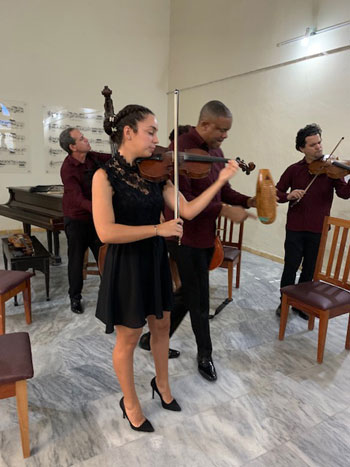
One music group was Concerto Sur of Cienfuegos, a well
-practiced, technically excellent string ensemble who filed onto
the staging area and danced while playing their instruments. She
also saw and heard lots of amateur artistry everything from street
and children's theater to breakdancing and hip hop to a whole
shop where newcomers could sit and paint as well as exhibit their
works. She saw one of her favorite troupes of street entertainers
on the first full day of her visit, while she was eating lunch at an
entrepreneurial family restaurant.
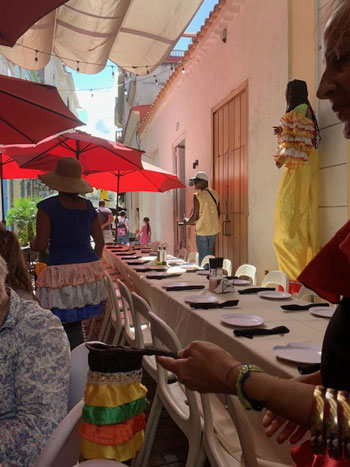
Musicians played horns and drums while fellow performers on
stilts and in colorful costumes paraded through the alley where
she and her group were seated.
Steiny encountered the most astounding piece of art, a brass
sculpture by world renown Cuban artist Roberto Fabelo installed
in 2013 in Havana's Plaza Vieja.
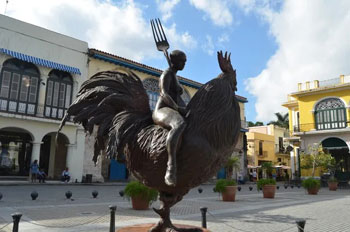
Shouldering a gigantic fork, a voluptuous, life-sized naked woman
wearing stiletto heels straddles a huge, one-legged rooster. While
the artist named the work Viaje Fantástico (old fantastic), he
offered no details concerning what inspired him to create this
work. Given the fork and fowl, many guess that the woman is a
working prostitute and that is how she can afford to eat.
According to Cuban historian Dr. Maritza Corrales, author of The
Chosen Island, who led an interactive session with Steiny's tour
group, Cubans are resilient and resourceful. In their spirituality,
they are more superstitious than religious which reflects African
heritage and traditions. Surprisingly, the largest spiritual group is
not those who practice Catholicism, but those who practice
Santeria or Regla de Ocha. This was initially a secret worship
practice by West African slaves who used Catholic saints to hide
the Yoruban religion and its gods. Steiny's Cuban guide pointed
out two Santeria women in a public square who were reading
fortunes through cards.
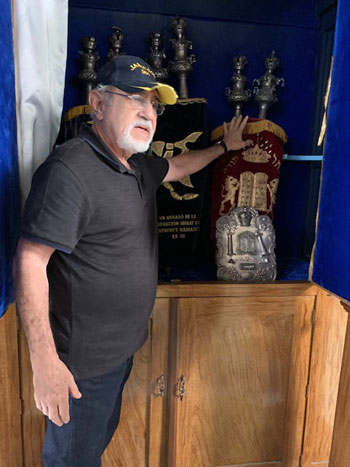
Dr. Corrales has written books on Jews in Cuba and told us that
historically Cuban Jews enjoyed a special respected status. Later,
Steiny's guides took her group to a Sephardic synagogue which
provides services led by a lay leader; no rabbis practice in Cuba.
On the rare occasion when a Jewish couple wants to marry, they
hire a rabbi from Venezuela. According to Jewish practice in
Cuba, this is the only time a rabbi must officiate.
Did Steiny have any fun during this educational tour of Cuba?
Absolutely!
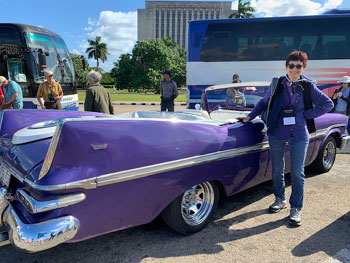
One afternoon, her tour company rented eight classic cars for her
group of 22. Steiny's driver, with his radio blaring per her
permission and his a-ooga horn punctuating his maneuvers, drove
her and her companions to see, among other places, Bosque de La
Habana (the Havana Forest) with its tall trees and curtains of
greenery.
She and her friends enjoyed a gorgeous sunset on the Caribbean
beach at their Trinidad hotel but came away with copious bug
bites from noseeums. Steiny also was invited to dance with Atila "
El Bendicido" (a Cuban television singer) at the farewell dinner.
Nothing like dancing mumbo with a flamboyant singer to put a
splendid cap on an exciting learning adventure.
Steiny says after visiting Cuba, obstacles and hard times are just
instances of wonder. Stay tuned, Steiny might revise her
equanimity after January 20, 2025.
|